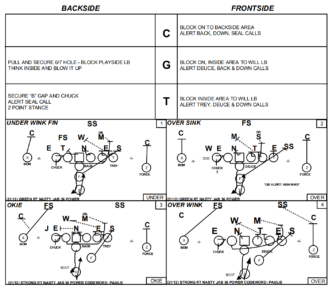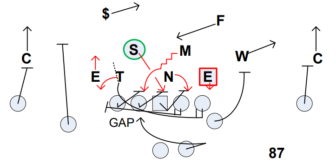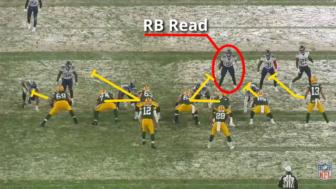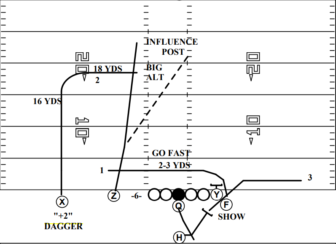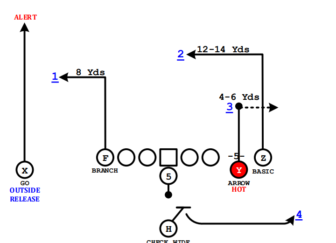
Outside zone has been a part of NFL run games for decades. It started to become popular in the 1980s and in the 1990s with Alex Gibbs and Mike Shanahan. It has become even more popular in the past few years with Kyle Shanahan and Sean McVay basing their entire offenses around the scheme. The scheme attacks space instead of players and offers a versatile play that doesn’t demand vertical movement and instead stresses defenses on the perimeter.
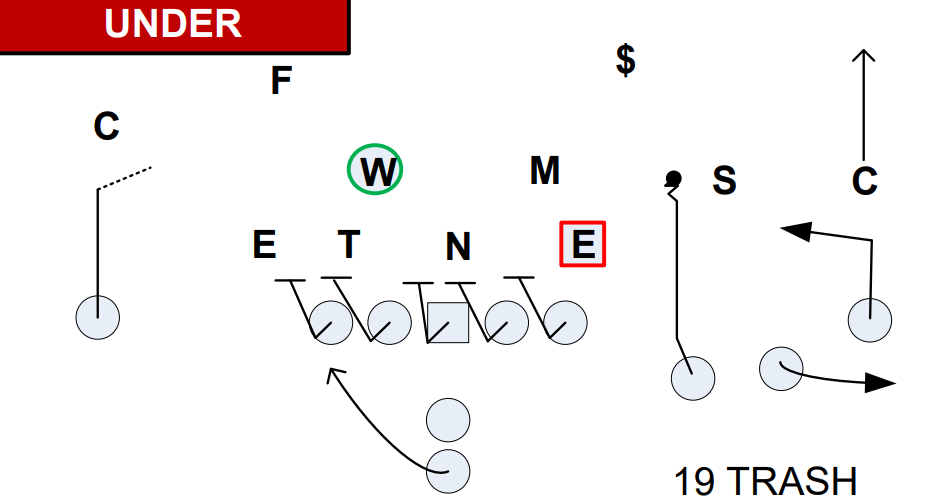
Outside Zone Philosophy
Outside zone forces defenses to run horizontally and puts more responsibility on the running back to make the blocking scheme of the offensive line effective. Even if offensive linemen lose ground, the back can run off of those blocks and create positive plays that exploit fast-filling linebackers. With an outside track, linebackers and second level defenders have to respect the threat of the offense getting the edge. That can then open huge cutback lanes in the middle of the field for running backs to take advantage of. Zone blocking philosophies can differ, but since it attacks space and gaps, the scheme can be incredibly versatile and effective against whatever front and look the defense presents.
Power
Outside Zone Assignments
There are two general approaches to how outside zone is taught. The numbering system and the filled/unfilled system. Both ultimately accomplish the same thing. Each system is taught slightly differently within each team and small adjustments are made via game plans, but generally, this is how they work:
Numbering System:
In the numbering system, the first defender to the play-side is labeled as the “0”. The second player is a “1”, the third is a “2”, and so on. If players are stacked, the lower number goes to the defender closer to the line of scrimmage.
The first player backside (of the center) is labeled as “-1”. The second player is a “-2”, and so on. These number labels on the defense correlate to numbers given to the offensive linemen. The center is “0”, the play-side guard is “1”, play-side tackle is “2”, backside guard is “-1”, and the backside tackle is “-2”. Linemen block their corresponding number while still working within the technique of the outside zone scheme.
This creates man-blocking principles within the zone blocking system. Offensive linemen must still take outside tracks (which will be covered below) and work through any first level defenders to get to their number. Those numbers for the defense can adjust in real time with pre-snap motion and fakes that move defenders into different alignments.
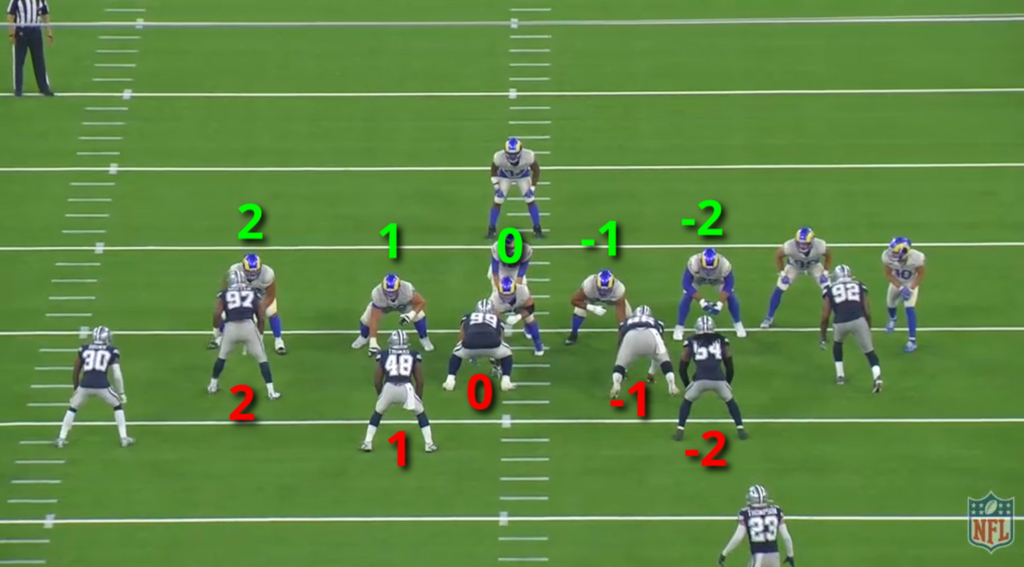
Filled/Unfilled System:
The filled/unfilled system prioritizes their rules based on whether the play-side gap of an offensive lineman has a defender in it or not. Assignments change based on whether there is a defender present in their gap or not.
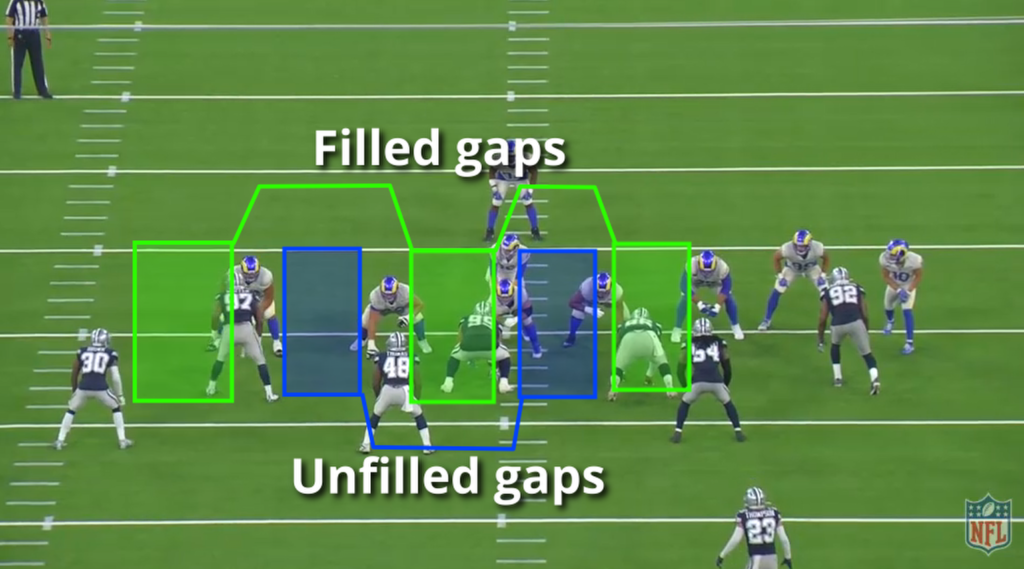
Counter
Running Back:
- Aiming point is the outside leg of the ghost tight end (ghost means whether a tight end is actually in the formation or not)
- The running back reads outside in from the end man on the line of scrimmage to the defensive tackles
- Essential to take a good track to force linebackers to flow over and set up easy blocks for the offensive linemen
- If the running back has a lane outside, they must immediately take it
Offensive Line:
- Play-side Tackle (PST)
- Filled / Unfilled:
- Attack the play-side end man on the line of scrimmage (EMLOS) with goal to seal outside
- If the end man on the line of scrimmage is outside their frame and in a wide enough alignment that an overtake is not possible, they must kick out that player
- When the EMLOS is possible to overtake and seal, the PST will take lateral steps (losing ground if needed) to win the outside
- If the play-side guard is able to overtake the EMLOS, climb and look for play-side linebacker inside to prevent scrape
- Attack the play-side end man on the line of scrimmage (EMLOS) with goal to seal outside
- Numbering:
- Attack play-side shoulder of “2”
- If the end man on the line of scrimmage is outside their frame and in a wide enough alignment that an overtake is not possible, they must kick out that player
- If the EMLOS is possible to overtake and seal, the PST will take lateral steps (losing ground if needed) to win the outside
- Attack play-side shoulder of “2”
- Filled / Unfilled:
- Play-side Guard (PSG)
- Filled / Unfilled
- Filled:
- Attack the play-side shoulder of the defender in your gap
- Unfilled:
- Take three steps flat with goal to overtake for the offensive lineman to your play-side
- If you cannot overtake or push over defender onto your play-side tackle, climb to first linebacker play-side
- Filled:
- Numbering:
- Attack “1” with same technique as filled/unfilled
- Work through first level defenders that appear
- Attack “1” with same technique as filled/unfilled
- Filled / Unfilled
- Center (C)
- Filled / Unfilled:
- Filled:
- Attack the play-side shoulder of the defender in your gap
- Unfilled:
- Take three steps flat with goal to overtake for the offensive lineman to your play-side
- If you cannot overtake or push over defender onto your play-side tackle, climb to first linebacker play-side
- Filled:
- Numbering:
- Attack “0” with same technique as filled/unfilled
- Work through first level defenders that appear
- Attack “0” with same technique as filled/unfilled
- Filled / Unfilled:
- Backside Guard (BSG)
- Filled / Unfilled:
- Filled:
- Attack the play-side shoulder of the defender in your gap
- Unfilled:
- Take three steps flat with goal to overtake for the offensive lineman to your play-side
- If you cannot overtake or push over defender onto your play-side tackle, climb to second linebacker play-side
- Filled:
- Numbering:
- Attack “-1” with same technique as filled/unfilled
- Work through first level defenders that appear
- Attack “-1” with same technique as filled/unfilled
- Filled / Unfilled:
- Backside Tackle (BST)
- Filled / Unfilled:
- Filled:
- Attack the play-side shoulder of the defender in your gap
- Unfilled:
- Take three steps flat with goal to overtake for the offensive lineman to your play-side
- If you cannot overtake or push over defender onto your play-side tackle, climb to second linebacker play-side
- Filled:
- Numbering:
- Attack “-2” with same technique as filled/unfilled
- Work through first level defenders that appear
- Attack “-2” with same technique as filled/unfilled
- Filled / Unfilled:
Some general rules that are applied to these systems:
- Defensive players lined head-up are treated as players that can fill gaps to either side
- Footwork and tracks stay the same
- Linebackers walked up in gaps are treated as filling those gaps and become priority assignments
- A defender in your play-side gap overrides a defender that is head up
Duo Concept
Examples
Contrary to its name, outside zone doesn’t usually hit outside. The goal is to stress the defense horizontally and the back has to be ready to take it if it’s there, but especially at the NFL level, getting on the edge is unlikely.
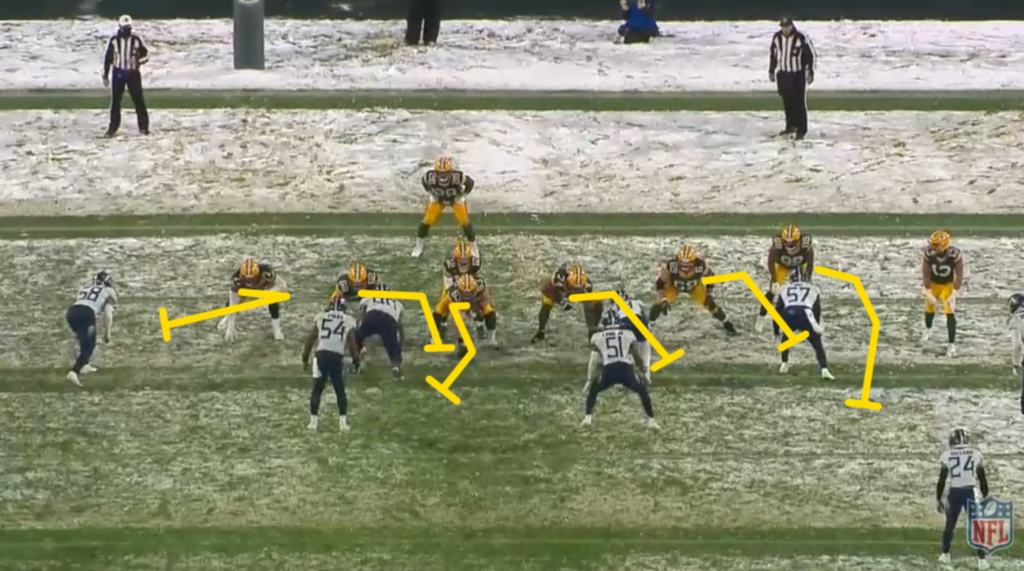
Here, the end man on the line of scrimmage to the play-side jabs in on the snap which allows for left tackle David Bakhtiari to be able to seal him and give the Packers the outside. The left guard has someone in their play-side gap so they attack their play-side shoulder.
The Packers here choose to help their backside guard with their center. The center gives a quick hand to help the guard overtake his man. That means the center will work to the backside linebacker and not the play-side linebacker (PSLB). That PSLB that’s unblocked is now the responsibility of the tight end. There is nobody in his play-side gap, so he helps the tackle overtake the block and then looks inside for exactly this type of flow from the linebackers. He helps seal that scrape and AJ Dillon is able to get outside on edge of the defense.
When the EMLOS is aligned in a wide-9 technique or way outside the PST, the PST now has to kick that player out.
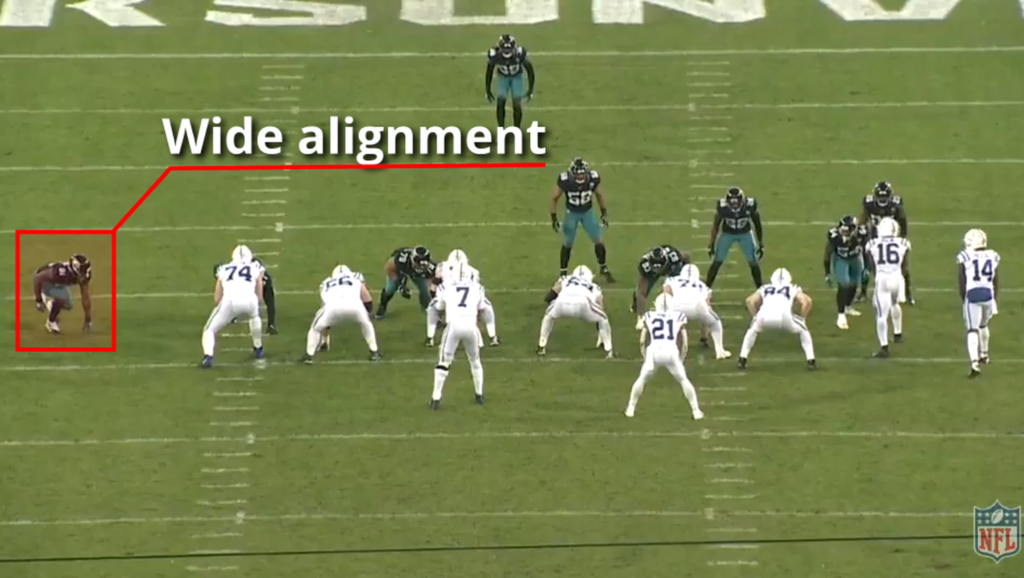
Running backs also have to be able to key and see that pre-snap to adjust their track accordingly. The PST kicks out the end and Quentin Nelson is able to sustain his block long enough to allow the running back to shoot the gap. The center does an excellent job of helping on his defensive tackle and then passing them off to the BSG.
Dagger Concept
Zone is great because it takes into account any spikes or slants from the defensive line. As that defensive tackle slants inside, the center leaves them because he knows his BSG is going to be on his 3-step track to overtake. That means he can leave and climb after his own three steps and get onto a linebacker. The backside tackle and tight end fight to cut off their defenders and prevent them from shooting gaps.
This outside zone from the Rams is a great example of an overtake from the BSG and BST. It also shows the running back reading sequentially down the line. The defensive line wins outside leverage from both the defensive end and play-side defensive tackle spots. That tells the running back to adjust his track to be inside of those two defenders. As soon as they seal, he shifts his eyes one gap inside.
That’s where the overtake comes into play. The backside guard takes his track to overtake for the center while putting his hand on the near hip of the player in his backside gap. That pressure allows for the BST get down the line of scrimmage and to be able to overtake the first-level defender. In turn, that allows the BSG to climb up to the linebacker. This all creates a ton of pursuit to the play-side and opens up a small crease on a cutback for the running back.
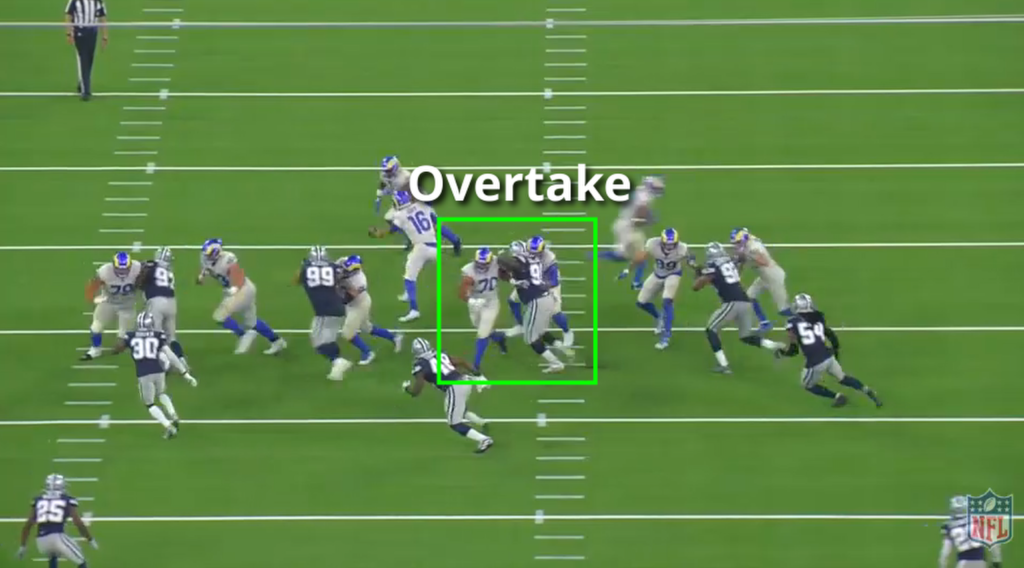
Here is one last example of how the flow and horizontal pressure of outside zone can exploit defenses. The PST kicks out the EMLOS. The PSG works through the man that appears in his gap as he climbs to the linebacker and the center works to help him. The backside guard gives a post arm to help the BST overtake. The BSG then gets up to the second level. With the track of the running back, Jacksonville has forced the secondary of the Browns to flow hard over the top and get sealed off to the play-side. That opens up a nice lane down the middle. The 3rd level defenders have taken bad angles because of how hard the Jaguars pressed outside.
Bow Concept
Summary
Outside zone is a versatile run play that forces defenses to play disciplined while also respecting the threat getting to the outside. It works great as a horizontal flow and is common to use on boot legs and play action. The scheme is versatile, doesn’t ask offensive linemen to physically overpower defenders, and puts more responsibility on the running back to make the scheme work effectively.

